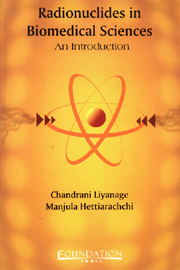Book contents
- Frontmatter
- Contents
- Forewords
- Introduction
- 1 Atomic and Nuclear Structure
- 2 Radiation Detectors
- 3 Units of Radiation Measurements
- 4 Iodine–125
- 5 Radioimmunoassay
- 6 Quality Control in RIA
- 7 Radiolabelled Compounds
- 8 Radiation Safety
- 9 Radiation Protection
- 10 Background Radiation
- 11 Storage
- 12 Contamination
- 13 Radioactive Waste
- References
1 - Atomic and Nuclear Structure
Published online by Cambridge University Press: 26 October 2011
- Frontmatter
- Contents
- Forewords
- Introduction
- 1 Atomic and Nuclear Structure
- 2 Radiation Detectors
- 3 Units of Radiation Measurements
- 4 Iodine–125
- 5 Radioimmunoassay
- 6 Quality Control in RIA
- 7 Radiolabelled Compounds
- 8 Radiation Safety
- 9 Radiation Protection
- 10 Background Radiation
- 11 Storage
- 12 Contamination
- 13 Radioactive Waste
- References
Summary
Atoms, the smallest units of element, are composed of neutrons, protons and electrons. The neutrons and protons, which are heavier particles, together form the central nucleus of the atom around which the lighter electrons revolve.
The total number of electrons or protons in a neutral atom is known as ‘atomic number’ (Z) of the atom. The chemical properties of an element are determined by the number of electrons it has and hence by the atomic number. The number of neutrons is the ‘neutron number’ (N) and the total number of nucleons (neutrons and protons) is known as the ‘mass number’ (A). In an atom, the electrons are arranged in their shells whose energy increases with every increase in the number of shells.
The stability of the nucleus depends on various factors, one of which is the neutron to proton ratio (n/p); for example, in carbon nucleus there are 6 protons and 6 neutrons giving a value of 1 for n/p. On the other hand, iodine nucleus has 53 protons and 74 neutrons, and uranium nucleus has 92 protons and 146 neutrons. It is seen that the n/p ratio increases with Z from nearly 1 for the light elements to 1.6 for the heavy elements.
ISOTOPES
The atomic number for a given element is fixed. For example, hydrogen will always have Z = 1, uranium Z = 92, iodine Z = 53 etc.
- Type
- Chapter
- Information
- Radionuclides in Biomedical SciencesAn Introduction, pp. 3 - 10Publisher: Foundation BooksPrint publication year: 2008



